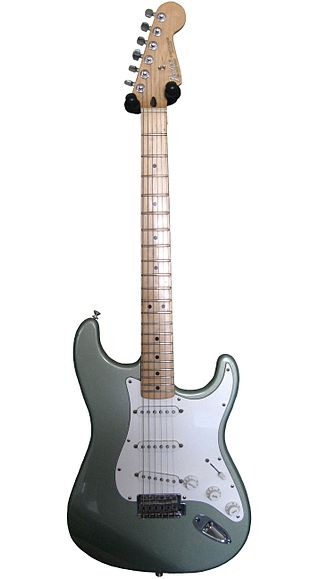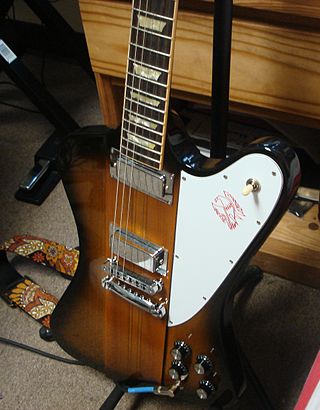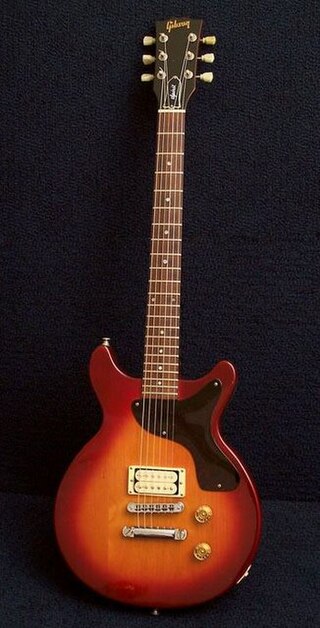Danelectro is a brand of musical instruments and accessories that was founded in Red Bank, New Jersey, in 1947. The company is known primarily for its string instruments that employed unique designs and manufacturing processes. The Danelectro company was sold to the Music Corporation of America (MCA) in 1966, moved to a much larger plant in Neptune City, New Jersey, and employed more than 500 people. Nevertheless, three years later Danelectro closed its plant.

The Fender Stratocaster, colloquially known as the Strat, is a model of electric guitar designed between 1952 and 1954 by Leo Fender, Bill Carson, George Fullerton, and Freddie Tavares. The Fender Musical Instruments Corporation has continuously manufactured the Stratocaster since 1954. It is a double-cutaway guitar, with an extended top "horn" shape for balance. "Stratocaster" and "Strat" are trademark terms belonging to Fender. Guitars that duplicate the Stratocaster by other manufacturers are sometimes called S-Type or ST-type guitars. Many prominent rock musicians have been associated with the Stratocaster for use in studio recording and live performances, most notably Eric Clapton, Buddy Holly, David Gilmour, Mark Knopfler, Jimi Hendrix, Stevie Ray Vaughan, Mark Speer and George Harrison.

The Fender Jazzmaster is an electric guitar designed as a more expensive sibling of the Fender Stratocaster. First introduced at the 1958 NAMM Convention, it was initially marketed to jazz guitarists, but found favor among surf rock guitarists in the early 1960s. Its appearance is similar to the Fender Jaguar, though it is tonally and physically different in many technical ways, including pickup design, scale length and controls.

The Gibson ES-335 is a semi-hollow body semi-acoustic guitar introduced by the Gibson Guitar Corporation as part of its ES series in 1958. It features a solid maple wood block running through the center of its body with upper bouts that are hollow and two violin-style f-holes cut into the top over the hollow chambers. Since its release, Gibson has released numerous variations of and other models based on the design of the ES-335.
The Fender Jaguar is an electric guitar by Fender Musical Instruments characterized by an offset-waist body, a relatively unusual switching system with two separate circuits for lead and rhythm, and a short-scale 24" neck. Owing some roots to the Jazzmaster, it was introduced in 1962 as Fender's feature-laden top-of-the-line model, designed to lure players from Gibson. During its initial 13-year production run, the Jaguar did not sell as well as the less expensive Stratocaster and Telecaster, and achieved its most noticeable popularity in the surf music scene. After the Jaguar was taken out of production in 1975, vintage Jaguars became popular first with American punk rock players, and then more so during the alternative rock, shoegazing and indie rock movements of the 1980s and 1990s. Fender began making a version in Japan in the mid-1980s, and then introduced a USA-made reissue in 1999. Since then, Fender has made a variety of Jaguars in America, Mexico, Indonesia and China under both the Fender and Squier labels. Original vintage Jaguars sell for many times their original price.

The Gibson Firebird is a solid-body electric guitar manufactured by Gibson beginning in 1963.

The Gibson Explorer is a type of electric guitar model by Gibson guitars, released in 1958. The Explorer offered a radical, "futuristic" body design, much like its siblings: the Flying V, which was released the same year, and the Moderne, which was designed in 1957 but not released until 1982. The Explorer was the final development of a prototype design that, years later, Gibson marketed under the name Futura.
The Fender Lead Series was produced by the Fender/Rogers/Rhodes Division of CBS Musical Instruments. The series comprised Lead I, Lead II, Lead III and Lead Bass models.
The Jackson Soloist is an electric guitar model introduced by Jackson Guitars in 1984, although prototypes were available before then. The design is a typical "superstrat"; it varies from a typical Stratocaster because of its neck-thru design; tremolo: Floyd Rose or similar, Kahler; or a fixed Tune-O-Matic; premium woods; a deeper cutaway at the lower horn for better access to the higher frets, and a sharper body with squared-off edges.

Fender Telecaster Custom is a model of electric guitar made by Fender.
The Fender Katana is an electric guitar built by Fender. It was designed by marketing director Dan Smith in 1985. The Katana was designed to compete with the unconventionally-shaped guitars of the era, such as the Jackson Randy Rhoads, and to satisfy Fender dealers who were suffering from the competition those instruments offered. The Katana did not sell as well as Fender hoped, and it was discontinued in 1986 before being reissued as a Masterbuilt Custom Shop model as part of the Prestige collection three decades later.
The Fender Telecaster Bass is an electric bass introduced in 1968 by Fender Musical Instruments Corporation. With few physical changes through the 1970s, it was discontinued in 1979 and reissued in 2007 by Fender's subsidiary Squier as the Squier Vintage Modified Precision Bass TB, which was discontinued in 2014.

The Univox Hi-Flier is an electric guitar marketed and sold by Univox from roughly 1967 to 1980. With its reversed offset body, the Hi-Flier has an intentional resemblance to the Mosrite Ventures model. A bass version of the Hi-Flier was also available.

The Rickenbacker 330 is part of Rickenbacker's 300 series of guitars. The 330 entered the Rickenbacker product line in 1958, though at the time the 300 series of guitars was known as the "Capri" series. It was designed by the German luthier Roger Rossmeisl. The guitar is associated by many players with the jangle-rock sounds of bands from the 1960s and 1980s. The instrument incorporates many features standard on Rickenbacker guitars, including a three-ply maple/walnut neck, a shallow headstock angle, and a thick rosewood fretboard finished with clear conversion varnish. The 330 also features a body with Rickenbacker's "crescent moon" double-cutaway shape with sharp, unbound edges, and an R-shaped trapeze tailpiece. One idiosyncrasy of the guitar is its dual truss rods, which allow for the correction of problematic and unwanted twists, as well as curvature, of the guitar's neck. The 330 is equipped with a monaural jack plate, lacking the Rick-O-Sound stereo functionality of other Rickenbacker models such as the Rickenbacker 360.
The Danelectro Shorthorn line of guitars is a dual cutaway hollow bodied design, made of Masonite and poplar. The original models were introduced in 1959 to replace the U model guitars, and were in production until the closure of the Danelectro company in 1969.

The Danelectro Amp-In-Case, properly known as a semi-hollow body due to its Masonite top and back, with pine outer structure. "All-in-one" Amplifier-Case or Silvertone 1448/1449/1451/1452/1457 is a line of guitar sets introduced from 1962 to 1968. It was sold for US$67.95, sometimes including a 45 rpm how-to-play record, as part of Sears Silvertone. It was later reissued in 2008 in modified form as the "Dano '63" without the amp-in-case. The Dano '63 was also available as a baritone guitar and a long- and short-scale bass guitar.

The Gibson Spirit was a guitar model sold under Gibson and Epiphone USA nameplates in the 1980s. This article does not refer to the made-in-China Spirit guitar sold under the Gibson Baldwin Music Education nameplate.

The Danelectro Dano Pro is an electric guitar made by Danelectro in 1963 and 1964, reissued in 2007 and again in 2012. The original was a 3/4 scale guitar with a single lipstick tube pickup, made by putting the pickup in surplus lipstick tubes purchased from a cosmetics supplier. The reissue features two lipstick pickups.The pickups are wired in series rather than in parallel as is common with most electric guitars. Because of this, the guitar is louder when the toggle is set to both the neck and bridge pickups rather than when only one pickup is selected. The guitar body is hollow, made of masonite and plywood with a maple neck and rosewood fingerboard. The body's vaguely trapezoidal shape has led to it being described as a bowtie or Flintstone guitar. The original had a short scale neck with a non-adjustable bridge. The reissue has a fully adjustable bridge and a full scale neck of 19 frets with the neck connecting to the body at the 14th fret. Because of this, playing the higher frets is nearly impossible. Its light tone and slight twang makes it very suitable for playing jangle pop, surf, country and blues. Guitarist Magazine said of the 2007 reissue "if it's Jack White or Jon Spencer dirty fuzzbox blues you are after, it's here in spades, alongside with Beatles-in-Hamburg rock 'n' raunch, garage punk venom and 1980s indie jangle."
The Danelectro C model guitars were the first instruments designed by Danelectro, coming in both single and dual pickup versions. Designed by 1953, until being replaced by the Danelectro U model in 1956. they were put into production and retailed from 1954 to 1955
The Fender Telecaster, colloquially known as the Tele, is an electric guitar produced by Fender. Together with its sister model the Esquire, it was the world's first mass-produced, commercially successful solid-body electric guitar. Its simple yet effective design and revolutionary sound broke ground and set trends in electric guitar manufacturing and popular music. Many prominent rock musicians have been associated with the Telecaster for use in studio recording and live performances, most notably Bruce Springsteen, Luis Alberto Spinetta, Keith Richards and George Harrison.











